technical data AUDI S8 2009 User Guide
[x] Cancel search | Manufacturer: AUDI, Model Year: 2009, Model line: S8, Model: AUDI S8 2009Pages: 408, PDF Size: 91.63 MB
Page 205 of 408
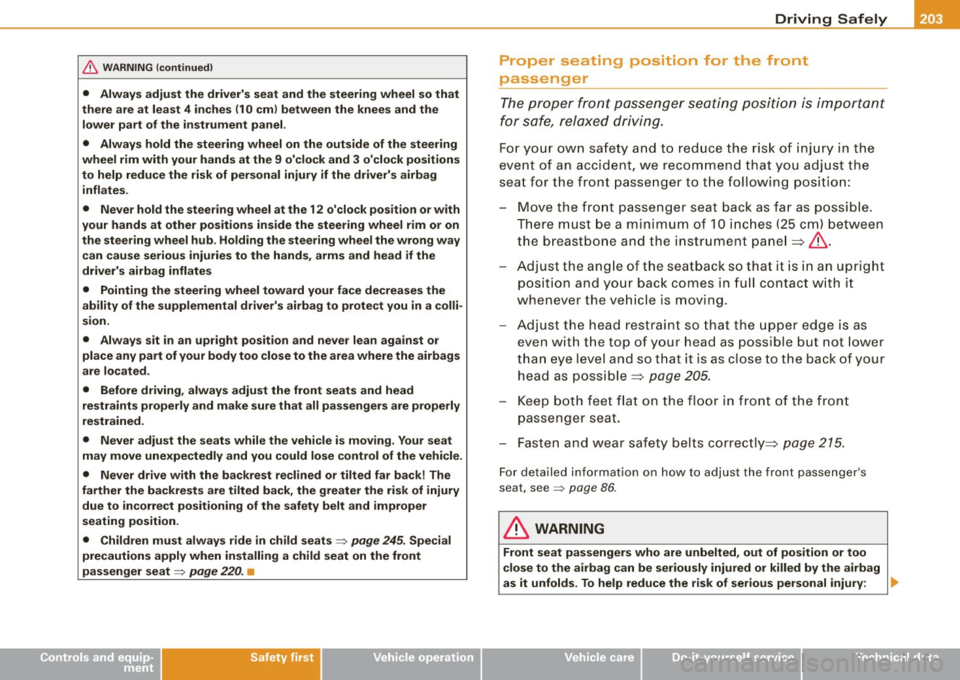
________________________________________________ D_r_iv _ i _n_ g~ S_ a_ fe_ ly __ l!III
& WARNING (continued)
• Always adjust the driver's seat and the steering wheel so that
there are at least 4 inches (10 cm) between the knees and the
lower part of the instrument panel.
• Always hold the steering wheel on the outside of the steering
wheel rim with your hands at the 9 o'clock and 3 o'clock positions
to help reduce the risk of personal injury if the driver's airbag inflates .
• Never hold the steering wheel at the 12 o'clock position or with
your hands at other positions inside the steering wheel rim or on
the steering wheel hub. Holding the steering wheel the wrong way
can cause serious injuries to the hands, arms and head if the
driver's airbag inflates
• Pointing the steering wheel toward your face decreases the
ability of the supplemental driver's airbag to protect you in a colli
sion .
• Always sit in an upright position and never lean against or
place any part of your body too close to the area where the airbags
are located.
• Before driving, always adjust the front seats and head
restraints properly and make sure that all passengers are properly
restrained .
• Never adjust the seats while the vehicle is moving. Your seat
may move unexpectedly and you could lose control of the vehicle.
• Never drive with the backrest reclined or tilted far back! The
farther the backrests are tilted back, the greater the risk of injury due to incorrect positioning of the safety belt and improper
seating position.
• Children must always ride in child seats
=> page 245. Special
precautions apply when installing a child seat on the front
passenger seat
=> page 220. •
Controls and equip
ment Safety first
Vehicle operation
Proper seating position for the front
passenger
The proper front passenger seating position is important
for safe, relaxed driving.
For your own safety and to reduce the ris k of injury in the
event of an accident, we recommend that you adjust the
seat for the front passenger to the following pos ition:
- Move the front passenger seat back as far as possible.
There must be a minimum of 10 inches (25 cm) between
the breastbone and the instrument panel =>
&.
- Adjust the angle of the seatback so that it is in an upright
position and your back comes in full contact with it
whenever the vehicle is moving.
- Adjust the head restraint so that the upper edge is as
even with the top of your head as possible but not lower
than eye level and so that it is as close to the back of your
head as possible =>
page 205.
-Keep both feet flat on the floor in front of the front
passenger seat.
- Fasten and wear safety belts correctly=:>
page 215.
For detailed information on how to adjust the front passenger's
seat, see => page 86.
& WARNING
Front seat passengers who are unbelted, out of position or too
close to the airbag can be seriously injured or killed by the airbag
as it unfolds. To help reduce the risk of serious personal injury : .,
Vehicle care Do-it-yourself service Technical data
Page 207 of 408

__________________________________________________ D _r_iv _ in_ g=- S_ a_f _e _l ___ y __ lffllll
Proper adjustment of head restraints
Correctly adjusted head restraints are an important part
of your vehicle's occupant restraint system and can help
to reduce the risk of injuries in accident situations.
Fig. 220 Correctly
adjusted head restraint
viewed from the side
The head restraints must be correctly adjusted to achieve
the best protection.
-Adjust the head restraint so that the upper edge of the
restraint is level with the top of your head, but no lower
than eye level and so it is as close to the back of your
head as possible ~ fig. 220.
Adjusting head restraints=> page 91.
& WARNING
Driving without head restraints or with improperly adjusted head
restraints increases the risk of serious injuries in a collision . To
help reduce the risk of injury :
• Always drive with the head restraints in place and properly
adjusted.
• Every person in the vehicle must have a properly adjusted head
restraint.
Controls and equip ment Safety first Vehicle operation
& WARNING (continued)
•
Always make sure each person in the vehicle properly adjusts
their head restraint. Each head restraint must be adjusted
according to occupants' size so that the upper edge is as even
with the top of the person's head, but no lower than eye level and
so it is as close to the back of to the head as possible .
• Never attempt to adjust head restraint while driving. If you
have driven off and must adjust the driver headrest for any reason,
first stop the vehicle safely before attempting to adjust the head
restraint.
• Children must always be properly restrained in a child restraint
that is appropriate for their age and size
=> page 245. •
Examples of improper seating positions
The occupant restraint system can only reduce the risk of
injury if vehicle occupants ore properly seated.
Improper seating positions can cause serious injury or
death . Safety belts can only work when they are properly
positioned on the body. Improper seating positions reduce
the effectiveness of safety belts and will even increase the
risk of injury and death by moving the safety belt to critical
areas of the body. Improper seating positions also increase
the risk of serious injury and death when an airbag deploys
and strikes an occupant who is not in the proper seating
position. A driver is responsible for the safety of all vehicle
occupants and especially for children. Therefore:
- Never allow anyone to assume an incorrect seating posi
tion when the vehicle is being used~& .
The following bulletins list only some sample positions that will
increase the risk of serious injury and death. Our hope is that these .,_
Vehicle care Do-it-yourself service Technical data
Page 209 of 408
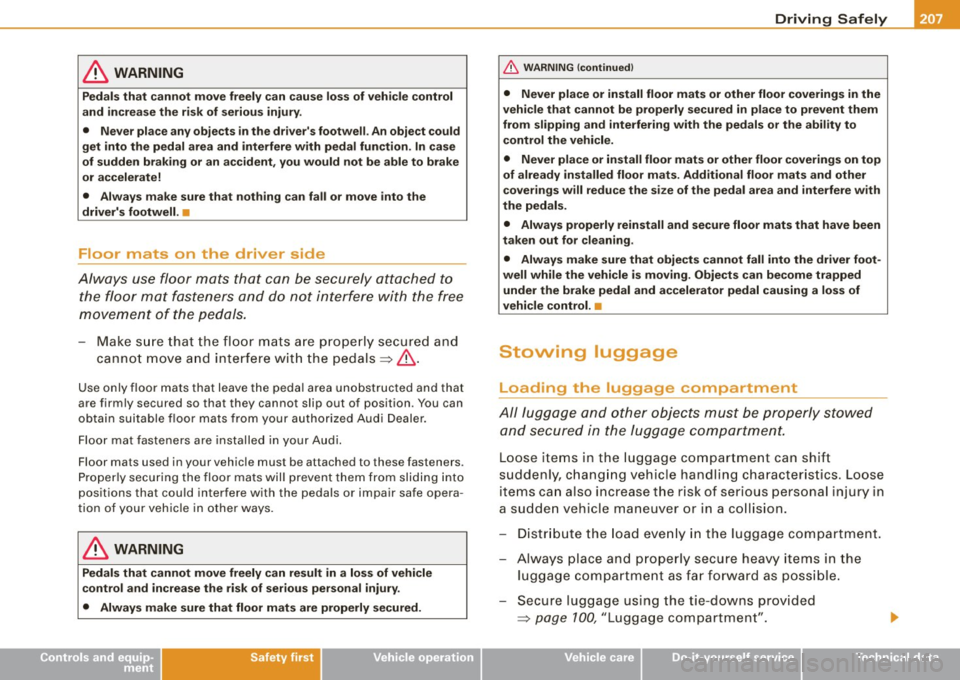
-------------------------------------------------=D..:.r..:...iv .:....:..:. in..:..:g~ S=- a =-=- fe~ ly~ -"'
& WARNING
Pedals that cannot move freely can cause loss of vehicle control
and increase the risk of serious injury.
• Never place any objects in the driver's footwell . An object could
get into the pedal area and interfere with pedal function. In case
of sudden braking or an accident, you would not be able to brake
or accelerate!
• Always make sure that nothing can fall or move into the
driver's footwell. •
Floor mats on the driver side
Always use floor mats that can be securely attached to
the floor mat fasteners and do not interfere with the free
movement of the pedals.
- Make sure that the floor mats are properly secured and
cannot move and interfere with the pedals =>& .
Use only floor mats that leave the pedal area unobstructed and that
are firmly secured so that they cannot slip out of position . You can
obtain suitable floor mats from your authorized Audi Dealer.
Floor mat fasteners are installed in your Audi.
Floor mats used in your vehicle must be attached to these fasteners .
Properly securing the floor mats will prevent them from sliding into
positions that could interfere with the pedals or impair safe opera
tion of your vehicle in other ways.
& WARNING
Pedals that cannot move freely can result in a loss of vehicle
control and increase the risk of serious personal injury.
• Always make sure that floor mats are properly secured.
Controls and equip ment Safety first Vehicle operation
& WARNING
(continued)
• Never place or install floor mats or other floor coverings in the
vehicle that cannot be properly secured in place to prevent them
from slipping and interfering with the pedals or the ability to
control the vehicle.
• Never place or install floor mats or other floor coverings on top
of already installed floor mats. Additional floor mats and other
coverings will reduce the size of the pedal area and interfere with
the pedals.
• Always properly reinstall and secure floor mats that have been
taken out for cleaning.
• Always make sure that objects cannot fall into the driver foot
well while the vehicle is moving. Objects can become trapped
under the brake pedal and accelerator pedal causing a loss of
vehicle control. •
Stowing luggage
Loading the luggage compartment
All luggage and other objects must be properly stowed
and secured in the luggage compartment.
Loose items in the luggage compartment can shift
suddenly, changing vehicle handling characteristics. Loose
items can also increase the risk of serious personal injury in
a sudden vehicle maneuver or in a collision.
- Distribute the load evenly in the luggage compartment.
- Always place and properly secure heavy items in the
luggage compartment as far forward as possible.
- Secure luggage using the tie-downs provided
=>
page 100, "Luggage compartment ".
Vehicle care Do-it-yourself service Technical data
Page 211 of 408
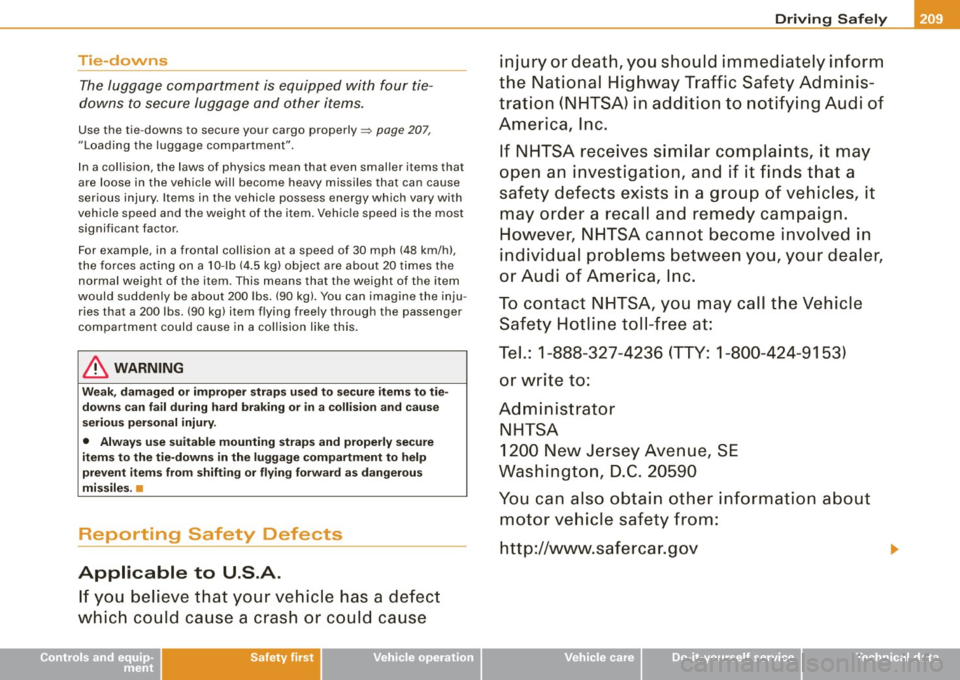
______________________________________________ D_ r_ iv _ in_ g~ S_ a_ fe_ly __ __
Tie-downs
The lugg age compa rtme nt is eq uippe d with f our tie
downs to secure luggage and othe r items .
Use the tie -downs to secure your cargo properly~ page 207,
"Loadi ng the luggage compartme nt".
I n a col lision, the laws of physics mean that even smaller items that
are l oos e in the veh ic le will become heavy missiles t hat can cause
serious injury. Items in the vehicle possess energy wh ich vary with
vehicle speed and the we ight of the item . Veh ic le spee d is the m ost
significant factor.
F or example, in a frontal co llision at a speed of 30 mph ( 48 km/h),
th e for ces act ing on a 10 -lb (4 .5 kg) o bject are about 20 tim es t he
normal weight of the item. This means that the weight of the item
w ould s udde nly be a bout 2 00 lb s. (90 kg). Yo u ca n imagi ne th e inju
ries that a 200 lbs. (90 k g) item flying free ly throu gh the pass enger
c o mp art ment co uld cause in a co llision lik e this.
& WARNING
Weak , damaged or improper straps used to secure items to tie
downs can fa il during hard braking or in a collision and cause
serious personal injury.
• Always use suitable mounting straps and properly secure
items to the tie -down s in the luggage compartment to help
prevent items from shifting or flying forward as dangerous
missiles .•
Reporting Safety Defects
Applicable to U.S.A.
If you believe that your vehicle has a defect
which could cause a crash or could cause
Controls and equip ment Safety first Vehicle operation
injury or death
, you should immediately inform
the National Highway Traffic Safety Adminis
tration (NHTSA) in addition to notifying Audi of
America , Inc.
If NHTSA receive s similar complaints , it may
open an investigation, and if it finds that a
safety defects exists in a group of vehicles , it
may order a recall and remedy campaign.
However , NHTSA cannot become involved in
individual problems between you, your dealer,
or Audi of America, Inc.
To contact NHTSA , you may call the Vehicle
Safety Hotline toll -free at:
Tel.: 1-888 -327-4236 (TTY: 1-800-424-9153)
or write to:
Admini strator
NHTSA 1200 New Jersey Avenue, SE
Washington, D.C. 20590
You can also obtain other information about
motor vehicle safety from:
http:/ /www.safercar.gov
Vehicle care Do-it-yourself service Technical data
Page 213 of 408
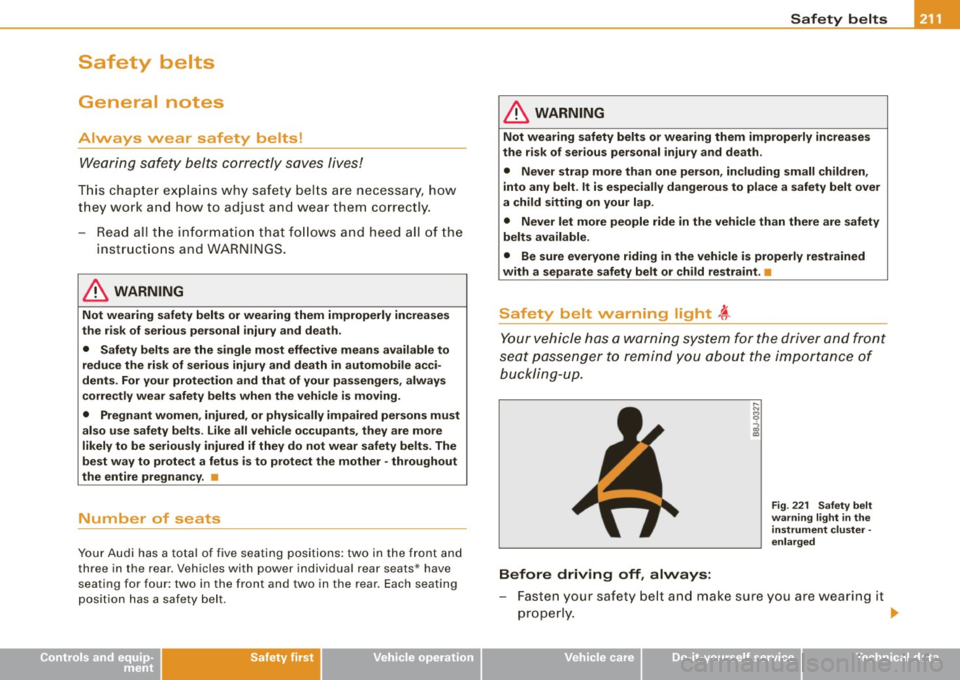
Safety belts -----------------=------
Safety belts
General notes
Always wear safety belts!
Wearing safety belts correctly saves lives!
This chapter explains why safety belts are necessary, how
they work and how to adjust and wear them correctly.
- Read all the information that follows and heed all of the
instructions and WARNINGS.
& WARNING
Not wearing safety belts or wearing them improperly increases
the risk of serious personal injury and death.
• Safety belts are the single most effective means available to
reduce the risk of serious injury and death in automobile acci
dents. For your protection and that of your passengers, always
correctly wear safety belts when the vehicle is moving.
• Pregnant women, injured, or physically impaired persons must
also use safety belts . Like all vehicle occupants, they are more
likely to be seriously injured if they do not wear safety belts. The
best way to protect a fetus is to protect the mother -throughout
the entire pregnancy. •
Number of seats
Your Audi has a total of five seating positions: two in the front and
three in the rear . Vehicles with power individual rear seats* have
seating for four: two in the front and two in the rear. Each seating
position has a safety belt.
Controls and equip ment Safety first
Vehicle operation
& WARNING
Not wearing safety belts or wearing them improperly increases
the risk of serious personal injury and death.
• Never strap more than one person, including small children,
into any belt. It is especially dangerous to place a safety belt over
a child sitting on your lap.
• Never let more people ride in the vehicle than there are safety
belts available.
• Be sure everyone riding in the vehicle is properly restrained
with a separate safety belt or child restraint. •
Safety belt warning light ~
Your vehicle has a warning system for the driver and front
seat passenger to remind you about the importance of
buck/ i ng-u p.
Before driving off, always:
Fig. 221 Safety belt
warning light in the
instrument cluster -
enlarged
- Fasten your safety belt and make sure you are wearing it
properly.
1J,,
Vehicle care Do-it-yourself service Technical data
Page 215 of 408
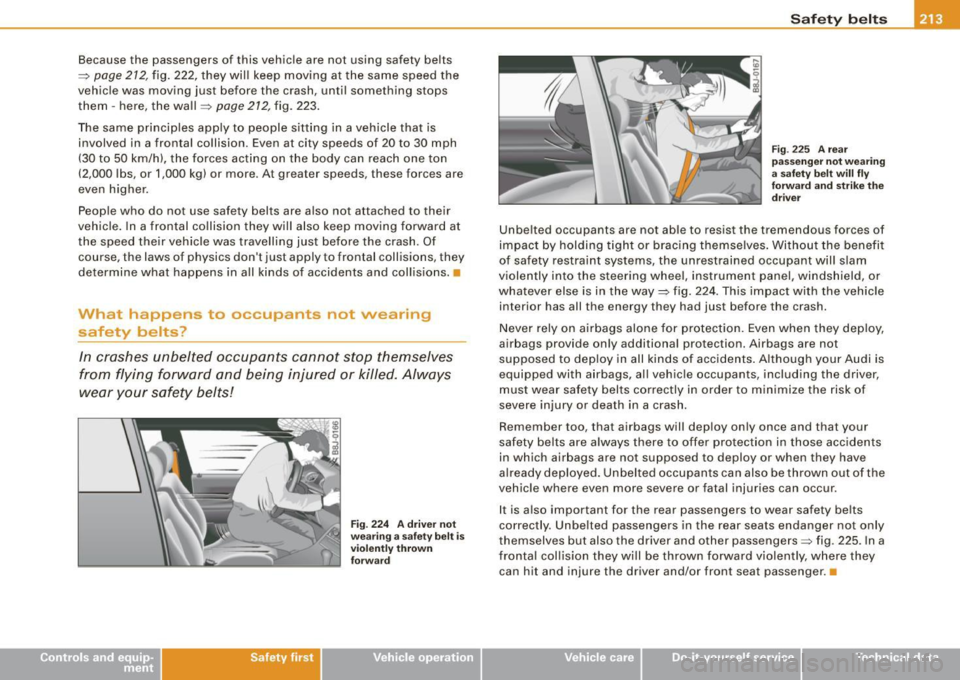
Because the passengers of this vehicle are not using safety belts
=:>
page 212, fig. 222, they will keep moving at the same speed the
vehicle was moving just before the crash, until something stops
them -here, the wall =:>
page 272, fig. 223.
The same principles apply to people sitting in a vehicle that is involved in a frontal collision. Even at city speeds of 20 to 30 mph
(30 to 50 km/h), the forces acting on the body can reach one ton
(2,000 lbs, or 1,000 kg) or more. At greater speeds, these forces are
even higher.
People who do not use safety belts are also not attached to their
vehicle. In a frontal collision they will also keep moving forward at
the speed their vehicle was travelling just before the crash. Of course, the laws of physics don't just apply to frontal collisions, they
determine what happens in all kinds of accidents and collisions. •
What happens to occupants not wearing
safety belts?
In crashes unbelted occupants cannot stop themselves
from flying forward and being injured or killed. Always
wear your safety belts!
Safety first
Fig . 224 A driver not
wearing a safety belt is
violently thrown
forward
Safety belts
Fig . 225 A rear
passenger not wearing
a safety belt will fly
forward and strike the
driver
Unbelted occupants are not able to resist the tremendous forces of
impact by holding tight or bracing themselves. Without the benefit
of safety restraint systems, the unrestrained occupant will slam
violently into the steering wheel, instrument panel, windshield, or
whatever else is in the way=:> fig. 224. This impact with the vehicle
interior has all the energy they had just before the crash.
Never rely on airbags alone for protection. Even when they deploy,
airbags provide only additional protection. Airbags are not
supposed to deploy in all kinds of accidents. Although your Audi is
equipped with airbags, all vehicle occupants, including the driver,
must wear safety belts correctly in order to minimize the risk of
severe injury or death in a crash.
Remember too, that airbags will deploy only once and that your
safety belts are always there to offer protection in those accidents
in which airbags are not supposed to deploy or when they have
already deployed. Unbelted occupants can also be thrown out of the
vehicle where even more severe or fatal injuries can occur.
It is also important for the rear passengers to wear safety belts
correctly . Unbelted passengers in the rear seats endanger not only
themselves but also the driver and other passengers=:> fig. 225. In a
frontal collision they will be thrown forward violently, where they can hit and injure the driver and/or front seat passenger. •
Vehicle care I I Technical data
Page 221 of 408
![AUDI S8 2009 User Guide _______________________________________________ S_a _f _e _t -=-y _ b_ e_lt _s __ ffllll
[ i ] Tip s
The safety be lt pretensioner can on ly be activated once.
• I n minor frontal and AUDI S8 2009 User Guide _______________________________________________ S_a _f _e _t -=-y _ b_ e_lt _s __ ffllll
[ i ] Tip s
The safety be lt pretensioner can on ly be activated once.
• I n minor frontal and](/img/6/57618/w960_57618-220.png)
_______________________________________________ S_a _f _e _t -=-y _ b_ e_lt _s __ ffllll
[ i ] Tip s
The safety be lt pretensioner can on ly be activated once.
• I n minor frontal and side collisions, in rear -end coll isions, in a
rollover and in accidents involving very litt le impact force, the safety
belt pretensioner are not activated .
• When the safety be lt pretensioner is activated, a fine dust is
released . This is normal and is not caused by a fire in the vehicle.
• T he relevant safety requirements must be observed when the
vehic le or componen ts of the system are scrapped . A qua lified deal
ership is familiar with these regulations and wil l be p leased to pass
on the information to you .
• Be sure to observe all safety, environmental and other regula
tions if the veh ic le or individual parts of the system, particu larly the
safety belt or airbag, are to be disposed . We recommend you have
your au thorized Audi dea ler perform this service fo r you .•
Service and disposal of safety belt
pretensioner
The safety bel t pretensio ners are parts of the safety be lts on your
Audi . Installing, removing, servicing or repairing of belt preten
sioners can damage the safe ty be lt system and preve nt it from
working correctly in a collision .
There are some important things you have to know to make su re
that the effectiveness o f the system w ill not be impaired and that
discarded components do not cause inju ry or po llute the environ
ment.
& WARNING
Improper car e, s ervicing and repair pro cedures can increa se the
ri sk of personal injury and death by preventing a safety belt
p ret ension er from activating when needed or activating it unex
pectedly :
Controls and equip
ment Safety first
Vehicle operation
& WAR N ING (continued )
• The belt pretens ioner system can be activated only once. If belt
preten sioner s ha ve bee n acti vated , the sy ste m mu st be replaced .
• Never repair , adjust , or change any part s of the safety belt
s y stem .
• Safety belt systems including safety belt preten sioner s ca nnot
be repai red. Speci al pro ced ures a re required for r emoval , in stalla
tion and di sposal of this system .
• For any work on the safety belt system , we str ong ly re com
mend that you see your authorized Audi dealer or qualified te chni
ci an who ha s an Audi approved repa ir m anual , train ing and spe cial
equipment nece ssary .
~ For the sake of the environment
Undeployed airbag modu les and pretensioners might be c lassif ied
as Pe rchlo rate Material -special handling may apply, see
www .dtsc.ca .gov /hazardouswaste/perchlorate . When the vehicle or
parts of the restraint system including airbag modules safety be lts
with pretensioners are scrapped, all applicable laws and regu la
t ions must be observed . Your authorized Audi dealer is familiar with
these requirements and we recommend that you have your dea ler
perfor m this service for you .•
Vehicle care Do-it-yourself service Technical data
Page 223 of 408
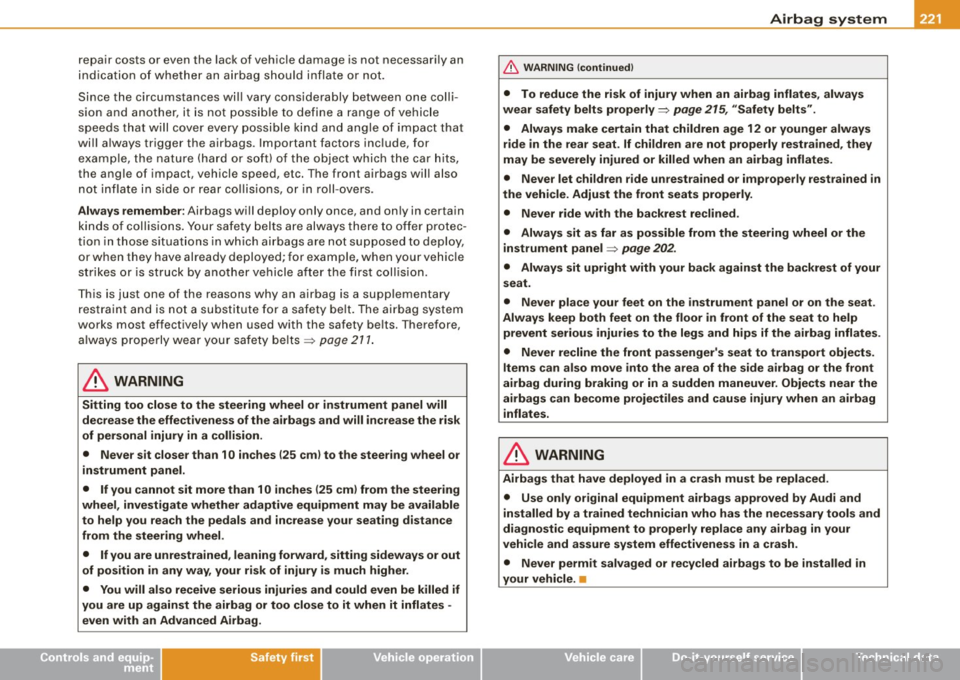
Airbag syst em -----------------=~-
repair costs or even the lack of vehicle damage is not necessari ly an
indication of whether an airbag should inflate or not.
Since the circumstances will vary considerably between one colli
sion and another, it is not possible to define a range of vehicle
speeds that w ill cover every possible kind and angle of impact that
will a lways trigger the airbags . Important factors inc lude, for
exa mple, the nature (hard or so ft) of the object which the car h its,
the angle of impact, vehicle speed, etc. The front airbags will also
n ot inflate in side or rear collisions, or in roll -overs .
Al way s rem ember : Airbags wi ll deploy only once, and on ly in certain
kinds of coll isions . Your safety belts are always there to offer protec
tion in those situat ions in wh ich airbags are not supposed to deploy,
or when they have already deployed; for example, when your vehic le
strikes or is struck by a nother vehicle a fter the first collision.
T his is just one of the reasons why an airbag is a supplementary
restraint and is not a substitute for a sa fety be lt. The airbag system
works most effectively when used with the safety be lts. Therefore ,
always prope rly wea r your safety belt s => page 211 .
& WARNING
Sitting too clo se to the steering wheel or in strument panel will
de crease the effect ivene ss of the airbags and will incr ease the risk
of personal injury in a collision.
• Never sit closer than 10 in ches (25 cm) to the steering wheel or
in strument panel.
• If you c annot sit more than 10 in ches (25 cm ) from the steering
wheel , inve stiga te whether adaptive equipment may be available
to help you reach the pedal s and in crease your se ating dist ance
from the steering wheel.
• If you are unrestra ined , leaning forward , sittin g side ways or out
of position in any way , your risk of injury i s much higher .
• You will also receive serious injur ies and could even be killed if
you are up again st the airba g or too clo se to it when it infl ates -
ev en with an Advanced Airbag .
Controls and equip ment Safety first
Vehicle operation
& WAR N IN G ( continued )
• To reduce the ri sk of injury when an airbag inflate s, alw ays
wear safety belt s prope rly~
page 21 5, "S afet y belt s".
• Always make certain that ch ildren age 12 or younger alway s
ride in the rear seat. If children are not p rope rly re str ained , they
may be severely injured or killed when an airbag inflate s.
• Never let children ride unre str ained or impr operly rest rained in
the vehicl e. Adju st the front seat s pr operly .
• Never ride with the b ackrest r eclined .
• Alway s sit a s far as possible from the steering wheel or the
instrument p anel
~ pag e 202.
• Alway s sit upright with your back again st the backre st of your
seat .
• Ne ver pla ce your feet on the instrument panel or on the seat .
Always keep both feet on the floor in front of the seat to help
prevent seriou s injurie s to the leg s and hips if the airbag inflate s.
• Nev er r ecline th e front passenger 's seat to transpo rt obje cts .
Item s can al so mo ve into the area of the side a irbag or the front
airbag during braking or in a sudden m aneuver . Obje cts near the
a irbags can become pro je ctile s and cau se injury when an airbag
inflates .
& WARNING
Airbags that have deployed in a crash must be repla ced.
• U se only original equipment airbags approved by Audi and
in stalled by a trained technician who ha s the neces sary tool s and
diagnostic equipment to properly r epla ce any airb ag in your
vehicle and as sure sy stem effectivenes s in a crash .
• Never perm it salvag ed or re cy cled airb ag s to be i nstall ed in
your vehicle. •
Vehicle care Do-it-yourself service Technical data
Page 225 of 408
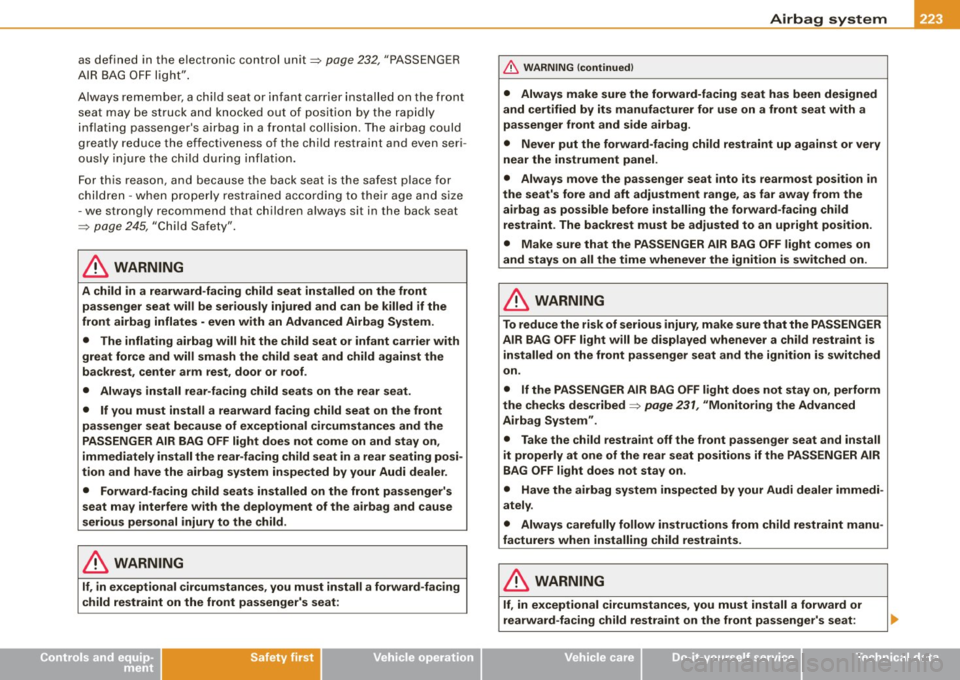
Airbag system -----------------=--=--------
as defined in the electronic control unit~ page 232 , "PASSENGER
AIR BAG OFF l igh t" .
A lways remember, a ch ild seat or infant carrier installed on the front
seat may be st ruck and knocked out of position by the rap idly
i n fl ating pass enger 's airbag in a fro nta l co llision . Th e airb ag co uld
g reatly reduce the effectiveness of the chi ld restraint and even seri
ousl y injure t he c hild duri ng i nflati on .
F or this reason, and because the bac k seat is the safest place for
ch ildr en -w he n prop erly res trained acc ording t o th eir age an d size
- we stro ngly recomm end that c hild ren a lwa ys sit in th e back seat
~ page 24 5, "C hil d Safe ty" .
& WARNING
A child in a rearward -facing child seat installed on the front
passenger seat will be seriously injured and can be killed if the
front airbag inflates -even with an Advanced Airbag System.
• The inflating airbag will hit the child seat or infant carrier with
great force and will smash the child seat and child against the
backrest , center arm rest, door or roof .
• Always install rear-facing child seats on the rear seat.
• If you must install a rearward facing child seat on the front
passenger seat because of exceptional circumstances and the
PASSENGER AIR BAG OFF light does not come on and stay on,
immediately install the rear -facing child seat in a rear seating posi
tion and have the airbag system inspected by your Audi dealer.
• Forward -facing child seats installed on the front passenger's
seat may interfere with the deployment of the airbag and cause
serious personal injury to the child .
& WARNING
If, in exceptional circumstances, you must install a forward-facing
child restraint on the front passenger's seat:
Controls and equip ment Safety first
Vehicle operation
& WARNING (continued)
• Always make sure the forward-facing seat has been designed
and certified by its manufacturer for use on a front seat with a
passenger front and side airbag .
• Never put the forward-facing child restraint up against or very
near the instrument panel .
• Always move the passenger seat into its rearmost position in
the seat's fore and aft adjustment range, as far away from the
airbag as possible before installing the forward-facing child
restraint. The backrest must be adjusted to an upright position .
• Make sure that the PASSENGER AIR BAG OFF light comes on
and stays on all the time whenever the ignition is switched on.
& WARNING
To reduce the risk of serious injury , make sure that the PASSENGER
AIR BAG OFF light will be displayed whenever a child restraint is
installed on the front passenger seat and the ignition is switched
on.
• If the PASSENGER AIR BAG OFF light does not stay on , perform
the checks described
~ page 231 , "Monitoring the Advanced
Airbag System" .
• Take the child restraint off the front passenger seat and install
it properly at one of the rear seat positions if the PASSENGER AIR
BAG OFF light does not stay on .
• Have the airbag system inspected by your Audi dealer immedi
ately .
• Always carefully follow instructions from child restraint manu
facturers when installing child restraints .
& WARNING
If, in exceptional circumstances, you must install a forward or
rearward-facing child restraint on the front passenger's seat :
Vehicle care Do-it-yourself service Technical data
Page 227 of 408
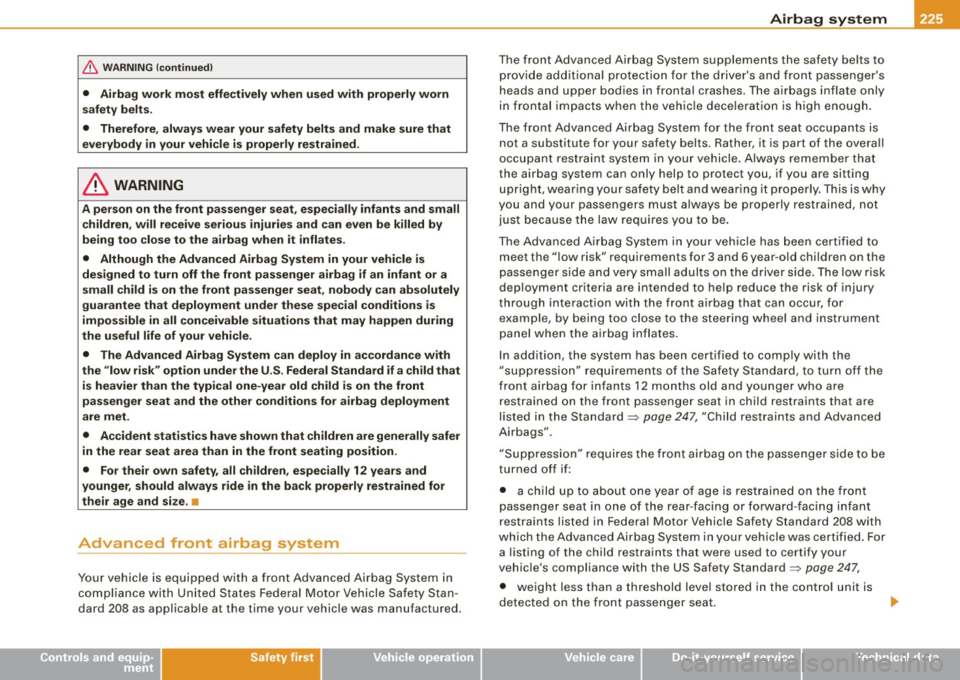
Airbag system -----------------=~-
& WARNING (continued )
• Airbag work most effectively when used with properly worn
safety belts.
• Therefore , always wear your safety belts and make sure that
everybody in your vehicle is properly restrained.
& WARNING
A pe rson on the front passenger seat , especially infants and small
children , will receive serious injuries and can even be killed by
being too close to the airbag when it inflates .
• Although the Advanced Airbag System in your vehicle is
designed to turn off the front passenger airbag if an infant or a
small child is on the front passenger seat, nobody can absolutely
guarantee that deployment under these spe cial conditions is
impossible in all conceivable situations that may happen during
the useful life of your vehicle.
• The Advanced Airbag System can deploy in accordance with
the "low risk" option under the U .S . Federal Standard if a child that
is heavier than the typical one -year old child is on the front
passenger seat and the other conditions for airbag deployment
are met.
• Accident statistics have shown that children are generally safer
in the rear seat area than in the front seating position .
• For their own safety , all children , especially 12 years and
younger , should always ride in the back properly restrained for
their age and size. •
Advanced front airbag system
Your ve hicle is equipped with a front Advanced Airbag System in
c o mp lia nce wi th United States Fede ral Moto r Vehicle Sa fety Stan
dard 208 as appl icab le at the time your vehicle was manufactured.
Controls and equip
ment Safety first Vehicle operation
T
he front Advanced Airbag System supplements the safety bel ts to
p ro v id e ad ditional p rotecti on for t he dr iver's an d fro nt p assenger's
heads and upper bodies in fronta l cras hes . The ai rbags inflate only
in fro ntal im pac ts whe n the vehic le dece le ra tio n is h igh enoug h.
T he fron t Adva nced Airbag System for the fron t seat occ upa nts is
not a substitute for your safety belts . Rather, it is part of the overa ll
occupa nt rest rai nt syste m in you r veh icle. A lways r em emb er that
the ai rbag system can only help to protect you, if you are sitting
u pr igh t, w ear ing yo ur safety b elt and w earin g it p ro perly . This is w hy
you and your passeng ers must a lways be prop erly r estrained, not
ju st beca use the law req uires y ou to be .
The Ad va nced A irbag System in you r ve hicle has been certi fied t o
meet the " low risk" req uirements f or 3 a nd 6 yea r-o ld child ren on the
p asse nger sid e and very s mall adu lts on t he dr iver s ide. The l ow risk
dep loyment crite ria are intended to he lp reduce t he ris k of in jury
th rough interac tion w ith the front a irb ag that can occur, for
examp le, by being too close to the stee ring whee l and instrument
p a nel wh en the a irbag i nflates.
I n add ition, the s yst em has been cert if ied to comply with the
"su ppressio n" re quir emen ts of the Sa fe ty Standa rd, to tu rn off th e
fr ont a irba g for in fa nts 12 months old and youn ger who a re
rest rained on the front passenger seat in child restraints that are
li ste d i n the Sta ndard:::::,
page 247 , "Child r estrai nts and Adva nced
A irbags".
"S upp ression" req uires the fron t airb ag on th e pas se nger s ide to be
turned off if:
• a child up to a bout one yea r of age is restrained on the front
passen ger seat in on e of the re ar -faci ng or forward -fac in g i nfa nt
restra ints listed in Federal Motor Vehicle Safe ty Standard 208 with
whi ch the A dvanc ed A irbag Sys tem in your vehic le w as c ertifi ed. For
a listing of the child rest raints that were used to cert ify your
v ehi cle's c om plia nce w ith the US S afet y Standar d:::::,
pag e 24 7,
• weight le ss than a threshold leve l stored in the cont ro l u nit is
d etected on the fr ont passe ng er sea t. .._
Vehicle care Do-it-yourself service Technical data